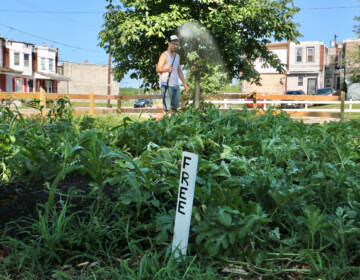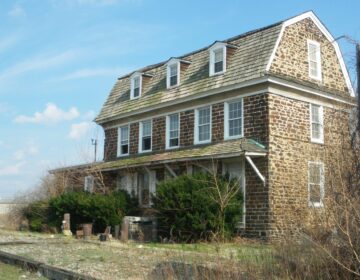Delaware tribe steps in at SugarHouse
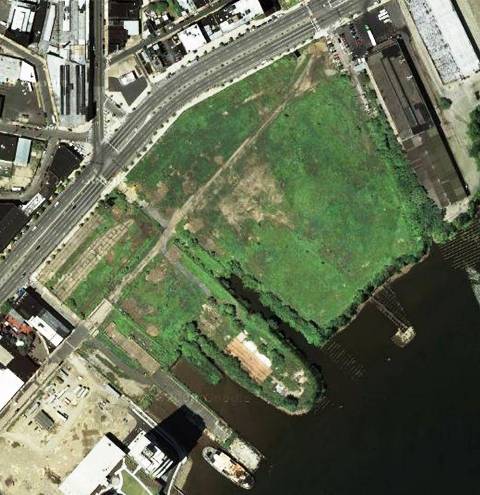
Feb. 29
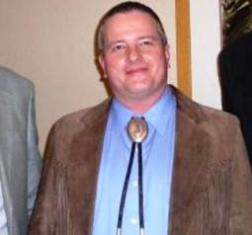
Video interview with Delaware Nation president Kerry Holton
By Kellie Patrick Gates
For PlanPhilly
Present-day leaders of the native people who signed a treaty with William Penn flew here from Oklahoma this week to protect whatever artifacts their ancestors left behind.
Kerry Holton, president of the Delaware Nation, and Tamara Francis, its cultural preservation director, walked the site slated for SugarHouse Casino. Archaeologists have already found arrow heads, tools, and evidence of fires used for cooking and warmth dating back thousands of years. Holton and Francis believe there is much more to be found – perhaps even a burial ground – so they will push hard for a more extensive search.
But a United States agency’s mistake nearly denied the Delaware, also called the Lenape, the chance to participate in this historic review – even though federal law mandates their inclusion.
This was not the first time that the Philadelphia District of the U.S. Army Corps of Engineers has overlooked the Delaware Nation, Francis said. But the exclusion from a review of a site that was pivotal in the Nation’s history prompted a March meeting of all western tribes with eastern ancestral lands. Francis was discussing the situation with a cultural preservation specialist from the Shawnee, and together, they decided a meeting was needed. The Shawnee will host the meeting, later this month. Francis also registered a complaint with the federal agency that oversees historic preservation.
And the handling of the SugarHouse situation has led the Army Corps to launch an internal investigation – conducted at the district, regional and national levels, to determine how the Delaware have been excluded.
“They weren’t intentionally left out of the process,” said Philadelphia district spokesman Khaalid Walls. “We’re going to do our best to make sure they are included in future projects.”
Holton, the Delaware Nation president, never thought the exclusion was on purpose. “We’re in another state,” he said. “We’re out of sight and out of mind.” But that does not make the mistake acceptable, he said.
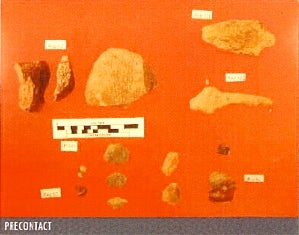
Artifacts found
While in Philadelphia, Francis noticed a mural near the SugarHouse site that depicts the Lenape signing the treaty with Penn. “Part of what we have to do is educate the community that these people they see in the murals on the wall are not extinct. We still exist!” she said. “Rather than everyone else interpreting our history for us, let us interpret our own history. We are our own experts.”
The historic review of the SugarHouse site, which has been under way for a year, is required because the casino needs a federal permit from the Army Corps to build into the Delaware River. The National Historic Preservation Act of 1966 – which was passed in response to the tear-down methods of modern development used in the 1950s and ’60s – requires the Corps to ensure that reasonable steps have been taken to preserve whatever history the site contains before issuing the permit, and the historic review is part of that process.
The Corps is in charge and has the final, decision-making power. But it is guided on the historic preservation aspects by the Pennsylvania Historical and Museum Commission and a group of interested citizens and representatives of interested organizations called advisory parties.
The federal law says when Native Americans have an interest in a property, they must be invited as an advisory party. But the Corps did not invite the Delaware Nation. Francis learned about the project from some of the other consulting parties – a group of local historians and history buffs who are also pushing for more extensive research at the site.
Most of the consulting parties were named in December. Francis wasn’t included until February, after she sent an email to James Boyer, a biologist in the small Philadelphia office of the Army Corps who is in charge of the review process.
“Their justification was that there are not any federally recognized tribes in Pennsylvania,” Francis said. But the fact that the Delaware are now headquartered in Oklahoma does not negate the fact that their ancestral lands included Philadelphia and other parts of Eastern Pennsylvania as well as New York, New Jersey, Delaware and parts of Maryland, she said.
Holton said that normally, Francis handles matters of historic preservation on her own. He joined her on this trip to Philadelphia because the Corps’ oversight also makes it a matter of The Delaware Nation’s sovereignty, he said. “By being overlooked, our sovereignty was disrespected,” Holton said. “These are not our laws, but their own laws that we are asking them to follow.”
Until now, the Philadelphia office of the Army Corps has never included the Delaware in a permit review, Francis said.
While making it clear the Army Corps is not the only government agency to exclude the Delaware in similar review processes, she reported the situation to the Advisory Council on Historic Preservation – the federal agency which oversees the National Historic Preservation Act and also serves as the appellate body when consulting parties are displeased with the process or results of a review.
“We want the Philadelphia Corps of Engineers to be held accountable for their actions over the past couple of decades,” she said.
Yet, Francis and Holton said this week’s meeting with the Corps and SugarHouse executives left them feeling optimistic, both that every step would be taken to recover historical artifacts from the SugarHouse site and that the Delaware would be included in future historical reviews.
It was the fact that the Delaware were excluded from the review of a site as potentially significant as the SugarHouse property that prompted Francis to take action. “The signing of the William Penn Treaty happened (near) here. That is a pivotal point in our history,” she said.
So far, in addition to the Delaware, the Shawnee, Absentee Shawnee, Kaw, Miami and Cherokee tribes have committed to the March meeting, Francis said. The Philadelphia situation has “put some fires under a couple of tribes,” she said.
Francis said one of her goals for the meeting is the creation of a list of all of the tribes who have ancestral lands in each state. Tribes who are invited to review the history of an area could use the list to inform government agencies if they have missed another tribe that should be included.
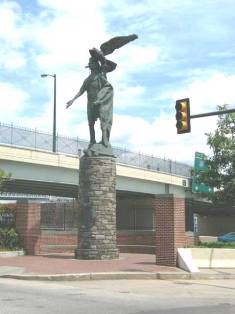
This sculpture at Front and Market commemorates Tamanend of the Lenni-Lenape nation who resided in the Delaware Valley when Philadelphia was established.
The Philadelphia District of the Army Corps – again with the help of the North Atlantic Division and national office – will be looking to see whether they missed another tribe that should be included as a consulting party, Walls said. Usually, consulting parties are chosen at the district level, he said. The additional oversight is “due diligence” because of further potential oversights, he said.
At the SugarHouse site, the casino’s archaeology consultant, A.D. Marble, has already unearthed more than 200 Native American artifacts. One of the arrowheads has characteristics of those used in about 1500 BC.
Marble has recommended another round of digging, including in a 50-by-30 foot area where Native artifacts were found. While findings like those discovered so far are common in this region, the report says “given the exceedingly low amount of sites found within the city limits of Philadelphia, the identification of this Native American site becomes very important within the context of the precontact record within Philadelphia’s boundaries. The information that could be contained in this small site would likely be a significant contribution to the understanding of precontact activities dating to times well before Native American contact with European explorers and settlers.”
Marble does not expect to find artifacts consistent with long-term living, however. Based on what has been found and what has not, “the Native American site represents a short-term occupation that included activities related to tool manufacture, low-scale resource processing, and the building of hearths related to produce heat for warmth and/or cooking,” the Conshohocken company says in its latest report.
But Holton said the site is a portion of the territory where, for millennia, his ancestors spent part of each year – when fishing was good and the weather not cold enough to force a move inland. It was not a temporary camp, but a seasonal home, until the Europeans forced Native Americans out of the area in the 1700s, he said.
The Delaware and other Native American tribes gathered at or near the SugarHouse site because the Delaware River and its tributaries made it an easy place to travel to by canoe. Local historians said the name Shackamaxon – both a street and an area near the site – means “meeting place of the chiefs.”
Lenape is the name the Delaware always used for themselves – it was the Europeans who named them The Delaware, Holton said. The name Lenape means “the original people,” he said, because the other Algonquin tribes split off from it. Those other tribes called the Lenape the “grandfather tribe,” he said, and often came here to consult with Lenape leaders.
While the Delaware Nation is now headquartered in Oklahoma, the bulk of its history took place in the east, and so it is sites like SugarHouse that offer the tribe the best means of learning more about their past, Holton said.
Marble “has not done enough archaeological research, and does not know enough about the particular people that lived their, either,” Holton said.

Geographic distribution of Eastern tribes.
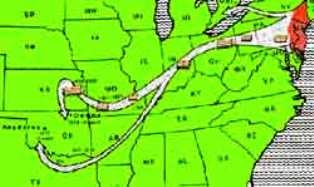
Movement of Delaware Nation west.
Local historians, including Torben Jenk of Kensington, have been saying for months that Marble does not know enough about what they might find.
Marble’s early reports said finding any Native American artifacts was unlikely. And they made no mention of British Fort #1 until Jenk provided copies of historic maps that show the Revolutionary War fort and a barracks were located on the site.
Francis said she will recommend that ground penetrating radar be used on the site as a non-invasive means to seeing what lies below the surface. “That has been used to discover actual structures, poles of long houses, burials, and other objects,” she said.
She feels confident based on meetings this week that SugarHouse and the Army Corps both want to do the right thing.
“We’ll do whatever we can do to protect the artifacts and history on the site,” SugarHouse spokeswoman Leigh Whitaker said. But since the Army Corps is in charge, she said, the casino will follow its lead. “We will follow the recommendations that the Army Corps and (the Pennsylvania Historical and Museum Commission) tell us.”
It will be at least a month before the Army Corps issues any decision about the permit SugarHouse seeks. A 30-day public comment period that is open to everyone has yet to begin, although Walls said the Corps is expected to announce its commencement at any time. Consulting parties have been given an extension – until March 7 – to turn in their comments. When asked if another extension might be granted, since it is possible that additional Native American tribes will be added as consulting parties, Walls said he did not know.
The Corps has the power to refuse to grant a permit based on the historic nature of an area. They can also grant a permit that goes into effect immediately with no further history-related requirements. But the Corps and other federal agencies more commonly take a middle ground approach, and issue a permit with preservation conditions that must be met before or during construction, said Bruce J. Milhans, a spokesman for the Advisory Council on Historic Preservation.
After the Corps makes its decision, anyone who is dissatisfied with it can appeal to the Advisory Council, Milhans said. If the Council decides to take action, it cannot overrule the Corps, he said. But its opinions are usually heeded, Milhans said, because the Council is a federal entity with federal department heads as members.
“When we get involved, the results are better for historic preservation,” he said.
Holton, President of the Delaware, found some humor in the situation:
“Usually, when Indians come to town, they want to bring a casino,” he said. “Here we are saying ‘Let’s hold off on building a casino here. Let’s preserve something.'”
But Holton said he has absolutely no problem with a casino going up on the site, provided his people’s history is preserved first.
Contact the reporter at kelliespatrick@gmail.com
WHYY is your source for fact-based, in-depth journalism and information. As a nonprofit organization, we rely on financial support from readers like you. Please give today.




